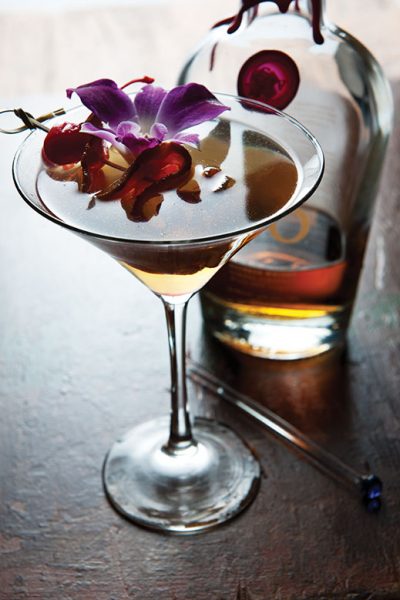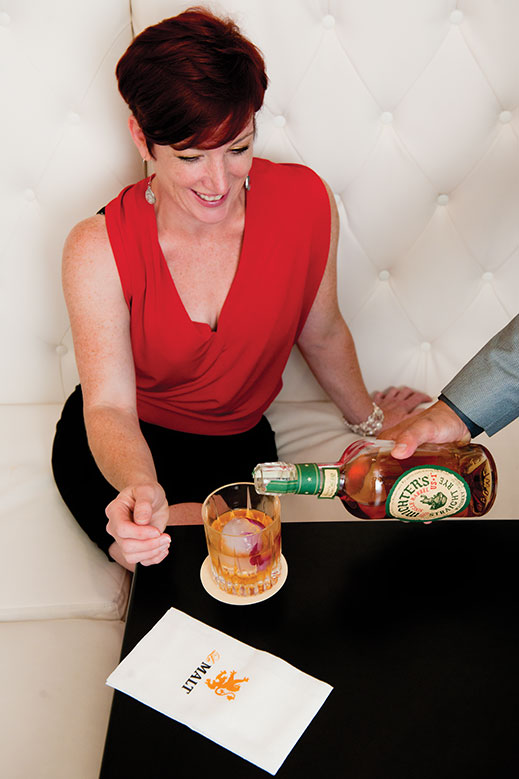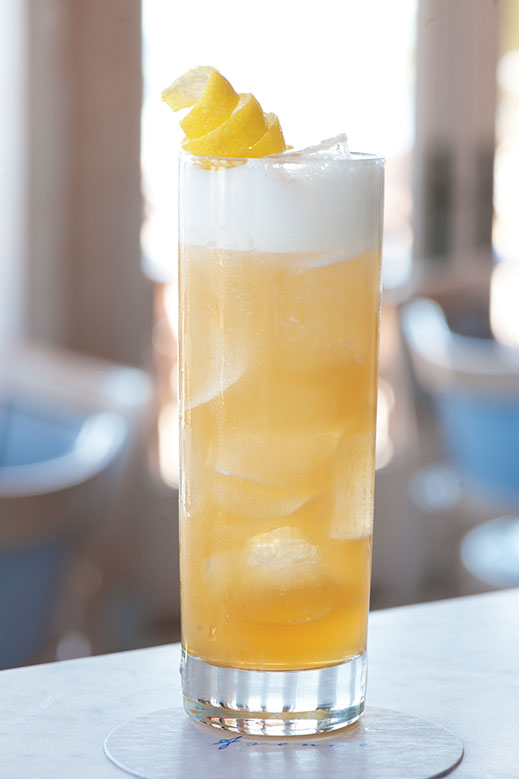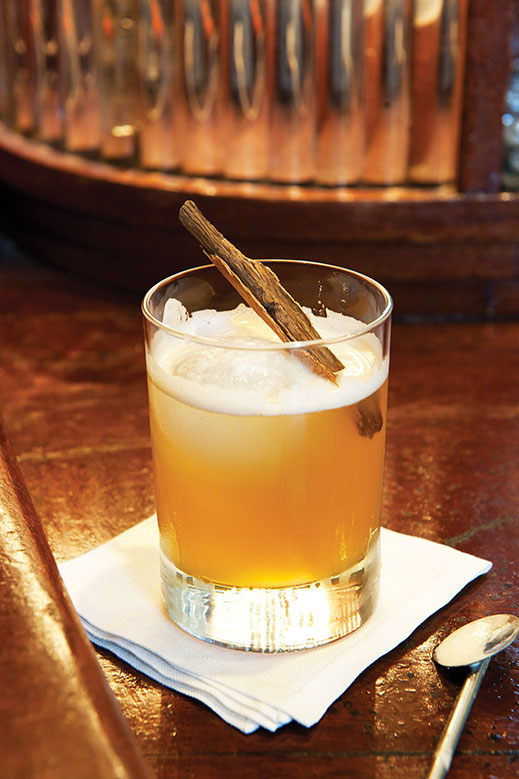
Joy Kennedy is not a cocktail girl. She takes her beer hoppy and her bourbon neat. But on this night, she has succumbed to the allure of mixology at Le Malt in Colonia. Sinking into a leather sofa, she contentedly sips a sangria spiked with Johnny Walker Platinum. As the fruity but potent concoction dissolves the stress of the day, a bartender in suit and tie readies her next drink, a Boardwalk Empire. It’s Le Malt’s twist on the classic Manhattan, consisting of Maker’s 46 (a premium bourbon from Maker’s Mark), a slab of house-smoked bacon and aromatic bitters.
Le Malt is the latest addition to New Jersey’s burgeoning whiskey scene. The striking, retro-mod cocktail lounge boasts more than 200 wines, 750 whiskeys, a menu for ice, and a $175 Billionaire Cocktail fashioned from Hennessy Paradis Cognac, Grand Marnier Cuvée 1880, Moët & Chandon Imperial Champagne, moonshine, and edible, 23-karat-gold flakes for garnish. The whiskey list includes three vintages of highly coveted Pappy Van Winkle bourbon, with the 20-year-old selling for $180 per glass or $2,000 a bottle.
Le Malt opened last September; the timing could not have been better. According to the International Bartenders Association, seven of the top 10 fastest-growing categories of spirits in the United States are whiskeys—specifically, brown whiskeys. Industry insiders are astonished by the sudden popularity of whiskey, especially among Millennials and Gen Xers. They use expressions like “flying off the shelves” to describe the phenomenon.
“It’s a palate thing,” says Himanshu Sahni, Le Malt’s director of marketing and communications. “Brown spirits are refined and unique, and once people get into that realm, their palate changes.”
Brown spirits include all styles of whiskey (bourbon, rye, American, Canadian, Irish and Scotch—blended and single malt), as well as brandy and aged rum.
The dictionary defines whiskey (spelled “whisky” in Scotland, Canada and Japan) as a spirit distilled from grain. All turn brown from barrel aging.
The ascent of brown spirits is a global phenomenon. Distillers around the world, especially in Japan and India, are creating their own styles of whiskey, some of which have been honored in international competitions. Le Malt carries seven bottles of Japanese or Indian origin. Large markets such as Brazil, Russia and China are drinking brown liquor as fast as they can import it. Last year, Suntory Holdings, a Japanese beverage group, spent an astonishing $16 billion to acquire Beam Inc., the parent company of Jim Beam and Makers Mark bourbons, Canadian Club and Courvoisier cognac.
A move away from vodka and other clear—or white—spirits is the corollary to the brown-liquor revolution. Carrie Bradshaw and her cosmo-loving friends in Sex and the City may have helped spark the cocktail culture of the late 1990s, but 21st-century tipplers are pushing aside vodka-tinis and searching the past for classic cocktails and their long-overlooked ingredients.
“People are over vodka,” says Thierry Carrier, director of operations at Le Club Avenue in Long Branch. “They want to try things that are more complex.” When Carrier opened Avenue in 2006, he had fewer than 20 orders a week for the bourbon cocktail on his menu. That number has more than tripled.
Some observers credit the collective change of taste to the single-malt Scotch proclivities of Don Draper, from the retro TV series Mad Men. Others suggest whiskeys slake a thirst that reaches back even further. This yearning might be summed up in one word: authenticity.
“Whiskey doesn’t just have a story. It has an authentic story,” says Lew Bryson, the Langhorne, Pennsylvania-based managing editor of Whisky Advocate and author of Tasting Whiskey (Storey Publishing, 2014). It’s a story of labor, love and a commitment to a painstaking distilling process. “There are almost no shortcuts,” says Bryson.
Modern drinkers want the sense of place whiskey provides. Whether it’s distilled in the Highlands of Scotland or the hills of Kentucky, production relies heavily on national traditions, clean water, years or decades of barrel aging, and often multiple generations of skill and labor. Local soil and climate conditions contribute what the French call terroir, a taste of place.
“Every brown spirit has a history,” says Sahni. “It’s always in the back of your mind that you’re drinking something special.”
Perhaps today’s whiskey drinkers also have a nostalgia for the Prohibition-era bootleggers and moonshiners who entered their living rooms via Boardwalk Empire. They call for whiskey cocktails like Manhattans, whiskey sours and old-fashioneds. They want house-made bitters (which masked the harsh flavors of whatever booze Prohibition barkeeps could access); and, increasingly, rye whiskey.
The resurgence of rye might be another nod to nostalgia. Pre-Prohibition imbibers actually guzzled rye whiskey in far greater quantities than other whiskeys. (Those are bottles of Canadian Club rye washing ashore at Nucky Thompson’s feet in the opening sequence of Boardwalk Empire.)
These days, New Jersey bartenders say the patrons they originally enticed with bourbon are evolving toward rye, a full-flavored and eminently mixable whiskey that’s spicier and drier than bourbon. “People think it’s cool and interesting to drink,” says Carrier.
Such trends exemplify the fickle nature of the whiskey market. It takes 2 to 10 years on average to barrel age bourbon and 8 to 20 to perfect a good Scotch. So it’s tragically easy to miscalculate future sales, which is what ruined the 20th-century bourbon industry.
Bourbon went for broke in 1950s and ’60s America, when a glass of whiskey and soda was de rigueur at parties. According to Fortune magazine, distillers in those decades put at least a million barrels a year into storage to meet the demands of what was expected to be an insatiable thirst. But by the 1970s, tastes turned to clear, un-aged spirits—in part because a younger generation of drinkers wanted to break from their elders’ preferred potables. Bourbon producers literally were left holding the barrel. Most either went out of business or sold off supply by mixing well-made product with neutral spirits and unloading it on the cheap for use in bland cocktails. By the end of the decade, brown whiskey had lost its cachet.
The situation began to change in 1984, when master distiller Elmer T. Lee introduced Blanton’s, the world’s first commercial single-barrel bourbon. Each bottle comes from a single aging cask, insuring consistently high quality, since it can’t be blended with another (ie, inferior) batch. The novelty intrigued drinkers, and Jim Beam and Brown-Forman—both based in Kentucky, like Blanton’s—began distilling more complex, older and higher-proof single-barrel brands like Knob Creek, Basil Hayden’s and Woodford Reserve, which remain popular today. In doing so, they sparked America’s new love affair with whiskey.
Scotch, too, has been buffeted by changing tastes. The Scotch Whisky Association reports that the value of exported Scotch lately has tumbled from its peak of $6.4 billion in 2011, the result of a push toward austerity by the government of China, where Scotch is a status symbol among the newly wealthy.
Still, Scotch has been largely ascendant since the late 1990s. Around that time, explains Bryson, some Scotsmen got hip to the idea that they could step up drinkers of commercial blends to more esoteric single-malts. Scotch started moving so fast that some producers began alienating the purists who make up their core constituency. In what appears to be a rush to get their products to market, nontraditional craft distilleries like Oban, Laphroaig and the Macallan have introduced bottles without age statements, much as craft distillers are testing accelerated—or “lightning”—aging processes. And like American distillers, who are broadening the appeal of bourbons with flavors like fruit, honey and cinnamon—the spicy-hot Fireball Cinnamon Whisky—some Scotch producers are livening up Scotch’s staid image by experimenting with novel approaches, such as finishing their liquid in beer or wine barrels.
Francis Schott, co-owner of Catherine Lombardi and Stage Left in New Brunswick, loves this direction. He cites Bruichladdich, a distillery on the Scottish isle of Islay (pronounced eye-lah), that turns out what he appreciatively calls “a bunch of crazy whiskys.” They come with names like Rocks and Black Art and pull the same types of headline-grabbing stunts that beer drinkers have come to expect from craft brewers. Example: the Octomore, which contains more peat than any Scotch in the world. “The Scottish are keeping it interesting,” Schott says. “They don’t only make your grandfather’s whiskey.”
Scotch producers have been selling high-end whiskey at staggering prices, as Schott can attest. Last year, a distributor offered him the chance to buy one of 15 bottles of 50-year-old, single-malt Balvenie being released in the United States—for $38,000. Schott tried pre-selling one-ounce pours for $1,800 each. He didn’t garner enough interest to go through with the promotion, but that doesn’t stop him from pouring ounces of Scotches like Arran Malt’s the Devils Punch Bowl (suggested retail price: $139 per bottle) and Duncan Taylor Glen Rothes 21-Year ($225 per bottle) at cost every Thursday. Those shots, he says, are polished off in a matter of hours—sometimes less.
At the Atlantic City Bottle Club, which carries more than 250 whiskeys, manager Paul Tonacci says the price of Scotch climbs between one and five dollars per bottle every year.
“I spend so much time readjusting my prices in the computer,” he laughs. “Whenever they enter new prices into the system, we have to adjust our own.”
But the contraction of the Asian Scotch market may portend what’s ahead for the industry as a whole. Most of the bartenders interviewed for this story say their patrons’ interest in Scotch is waning as 30-and 40-somethings develop palate fatigue, apparently weary of Scotch’s strong smoky essences.
What of the classic Scotch drinker—that white-haired executive who takes it neat after a round of golf? Has the country-club set traded in its Glenmorangie and Glenlivet?
It depends. Schott says Scotch is as popular as ever with his clientele. Yet in Peapack/Gladstone, Michael Smythe, beverage manager at Ninety Acres at Natirar, says patrons are starting the night with something unfamiliar from the bar, such as a bourbon cocktail, rather than Scotch on the rocks, then having wine with dinner.
Schott warns newcomers to look before they leap into overly hyped brands. “The most important thing these days is avoiding the bullshit,” he says. “There are a lot of whiskey brands out there that tell a very heartwarming story about Grandpa’s Prohibition-era recipe for moonshine, blah blah blah, and the juice is really made at a contract distiller. It’s laughable.”
Single-malt devotee Patrick Lilly sneers at some of the current trends. “Cocktails are for girls!” says the 36-year-old Scotch Plains man, who picks his poison at Newark bars like Allegro, Adega and Mompou. Each has an extensive whiskey selection.
Not so fast, Patrick. New Jersey bartenders acknowledge that women sample whiskey in mixed drinks more readily than straight or on the rocks. But rye and bourbon cocktails are popular with both sexes and all ages.
Rye and bourbon also bring out the creativity in modern mixologists. At Avenue, Carrier stirs rye whiskey, agave nectar, black tea and Meyer lemon for a variation on the old whiskey sour. At Ninety Acres, Smythe is following the lead of his craft-beer brethren, who are barrel aging certain brews, and executing his own barrel-aging program. He mixes bourbon cocktails, then stores them for up to three weeks in new charred oak, the very barrels that, by law, hold bourbon for aging.
“We’re putting the bourbon back into the vessel it came out of,” he says. “It gives it that slight bit of wood flavor and helps round out the cocktail and makes it a little more complex.”
The reintroduction of wood deepens the earthy and sentimental elements in the already-powerful whiskey narrative. Advertising agencies are happy to indulge this type of imagery, hoping the story will resonate with the new generation of drinkers—male and female.
“The Beam family has a long history of doing things their own way,” rasps actress Mila Kunis, sultry, sweaty, and surrounded by bourbon barrels and fire in a recent TV campaign to promote Jim Beam’s new tagline, “Make history.” In tapping Kunis, Beam epitomizes a marketing movement designed to seduce women—whom the company says comprise 37 percent of American whiskey drinkers—by appealing to their strength, confidence and individuality.
Couple that with the fact that women have served as distillers for many societies, and the tale takes on even more drama when Kunis slaps the barrel she’s just branded with a smoldering-hot iron shaped into her name and says, “Four long years from now, I’ll be back for this one.”
It’s an empowering message that plays well in Colonia, where, still seated at Le Malt, Joy Kennedy, a 44-year-old Ph.D and mom, explains why whiskey, and whiskey alone, invokes a timelessness that connects her to the past, present and future.
“Whiskey is no nonsense, not frilly, not frou-frou,” says Kennedy, who professes a love for Blanton’s. “You’re drinking something that someone conceptualized and made for you 25 years ago. The sense of history is like watching light travel.”
Freelance writer Tara Nurin started sipping Jameson Irish whiskey a decade ago. She has since developed an unenviable predilection for pricey Islay Scotches.






